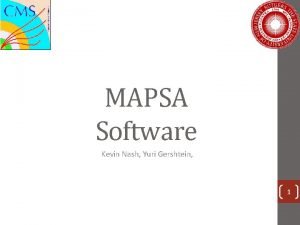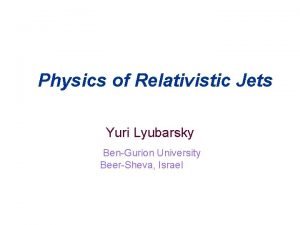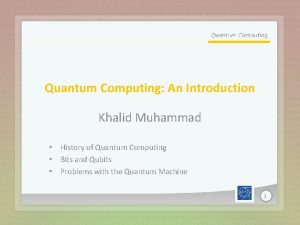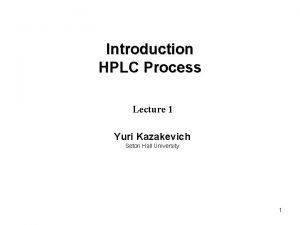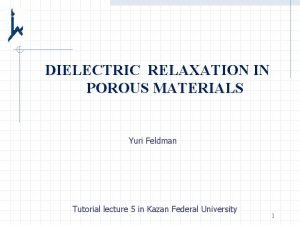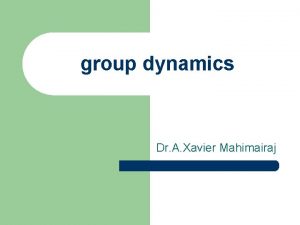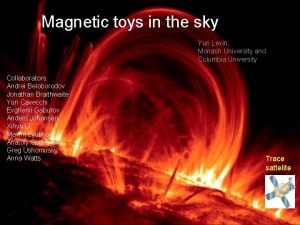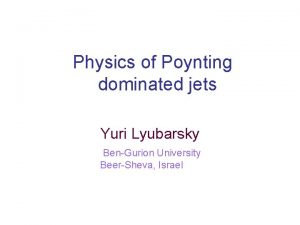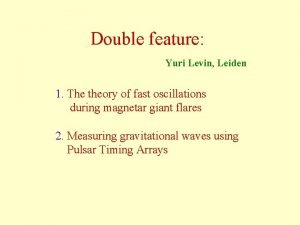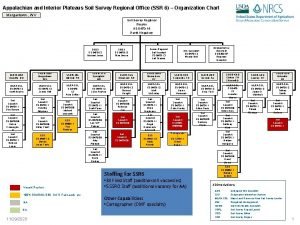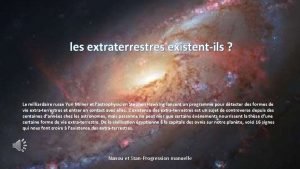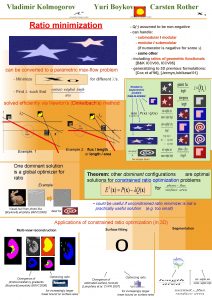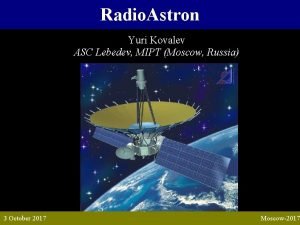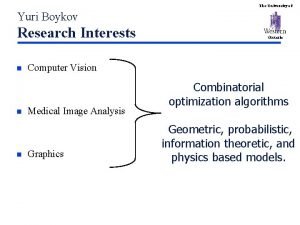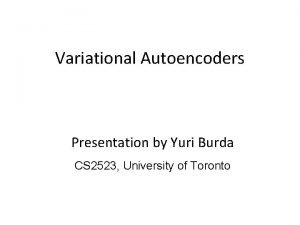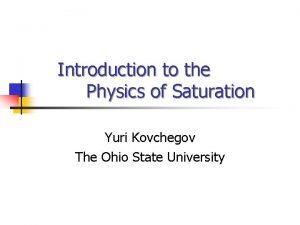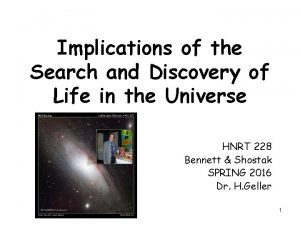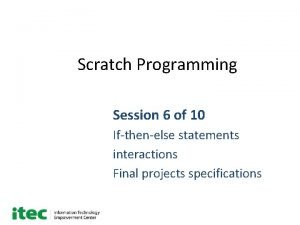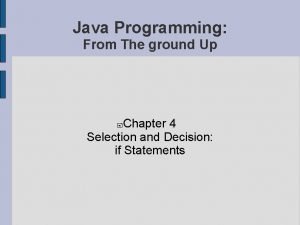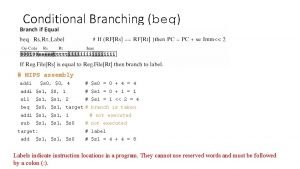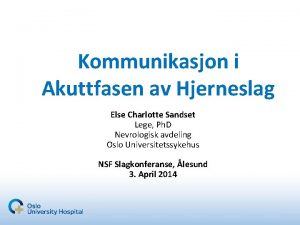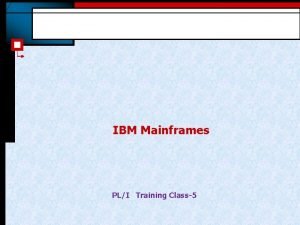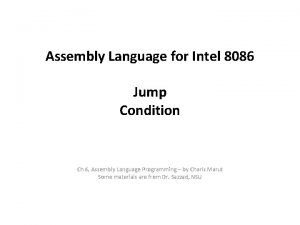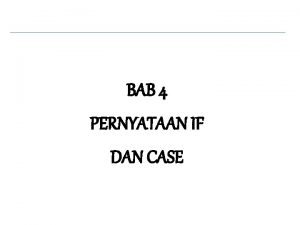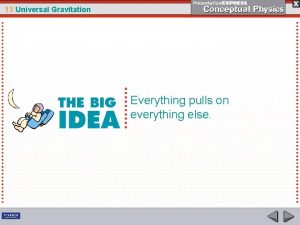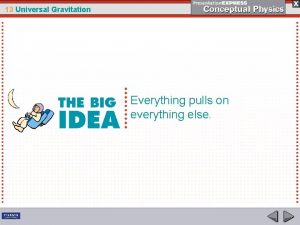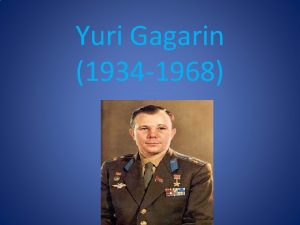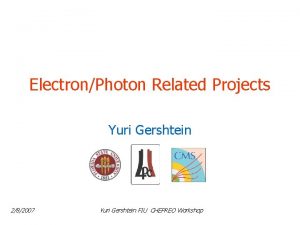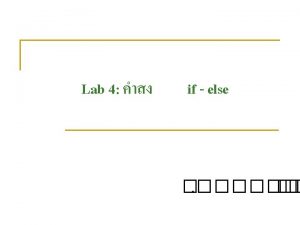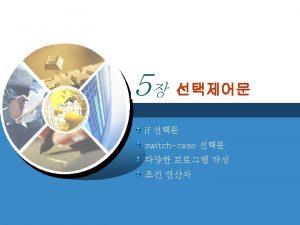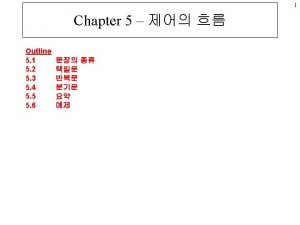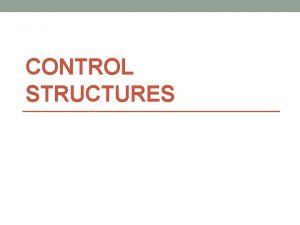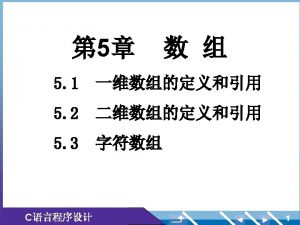Line Intensities CollisionalRadiative Modelingand everything else Yuri Ralchenko



![Rates velocity [cm/s] Collisional: Collisional projectile density [cm-3] Radiative: A [s-1] Radiative [s-1] cross Rates velocity [cm/s] Collisional: Collisional projectile density [cm-3] Radiative: A [s-1] Radiative [s-1] cross](https://slidetodoc.com/presentation_image_h/e133d3ab3c656337d474913d6433ced8/image-4.jpg)
































![Z-scaling of A’s • W[E 1]: A(1 s 2 1 S 0 – 1 Z-scaling of A’s • W[E 1]: A(1 s 2 1 S 0 – 1](https://slidetodoc.com/presentation_image_h/e133d3ab3c656337d474913d6433ced8/image-37.jpg)











- Slides: 48

Line Intensities, Collisional-Radiative Modeling…and everything else Yuri Ralchenko National Institute of Standards and Technology Gaithersburg, MD 20899, USA

Where does the story begin? . . plasma hν What happens here? 2

Spectral Line Intensity (optically thin) Einstein coefficient or transition probability (s-1) Upper state density (cm-3) (almost) purely atomic parameters strongly depends on plasma conditions Photon energy (J) Energy emitted due to a specific transition from a unit volume per unit time j Eij i
![Rates velocity cms Collisional Collisional projectile density cm3 Radiative A s1 Radiative s1 cross Rates velocity [cm/s] Collisional: Collisional projectile density [cm-3] Radiative: A [s-1] Radiative [s-1] cross](https://slidetodoc.com/presentation_image_h/e133d3ab3c656337d474913d6433ced8/image-4.jpg)
Rates velocity [cm/s] Collisional: Collisional projectile density [cm-3] Radiative: A [s-1] Radiative [s-1] cross section [cm 2] Lifetime = 1/A [s]

Z-scalings of atomic parameters • Radiative (A ~ f·∆E 2) • ∆n = 0 • ∆E ~ Z • f ~ Z-1 • A~Z • ∆n ≠ 0 • Collisional (σ~ f/∆E 2) • ∆n = 0 • σ ~ Z-3 • < σ·v> ~ Z-2 • ∆n ≠ 0 • σ ~ Z-4 • < σ·v> ~ Z-3 • ∆E ~ Z 2 • f ~ Z 0 • A ~ Z 4 • n-dependence • σ ~ n 4 • A ~ n-3 E 1 only! Forbidden: Z 6 -Z 12

Thermodynamic equilibrium ● Principle of detailed balance – Photons each direct process is balanced by the inverse ● ● ● excitation ↔ deexcitation ionization ↔ 3 -body recombination photoionization ↔ photorecombination autoionization ↔ dielectronic capture radiative decay (spontaneous+stimulated) ↔ photoexcitation Electrons Atoms Ions

TE: distributions ● Four “systems”: photons, electrons, atoms and ions ● Same temperature Tr = Te = Ti ● We know the equilibrium distributions for each of them – – Photons: Planck Electrons: Maxwell Populations within atoms/ions: Boltzmann Populations between atoms/ions: Saha

TE: energy scheme Saha Continuum Ionization energy Bound states Boltzmann: Energy Maxwell

Planck and Maxwell ● Planck distribution ● Maxwell distribution

Saha Distribution AZ (+ e) ↔AZ+1 + e (+ e) Z ionization autoionization Z+1 3 -body recombination dielectronic capture Which ion is the most abundant?

Local Thermodynamic Equilibrium • (Almost) never complete TE: photons decouple easily…therefore, let’s forget about the photons! • LTE = Saha + Boltzmann + Maxwell • Griem’s criterion for Boltzmann: collisional rates > 10*radiative rates H I (2 e. V): 2× 1017 cm-3 C V (80 e. V): 2× 1022 cm-3 • Saha criterion for low Te: H I (2 e. V): 1017 cm-3 C V (80 e. V): 3× 1021 cm-3

LTE Line Intensities ● No atomic data (only energies and statweights) are needed to calculate populations ● Intensity ratio ● Or just plot the intensities on a log scale: Boltzmann plot Aragon et al, J Phys B 44, 055002 (2011)

Saha-LTE conclusions • Collisions >> radiative processes • Saha between ions • Boltzmann within ions • Since collisions decrease with Z and radiative processes increase with Z, higher densities are needed for higher ions to reach Saha/LTE conditions • H I: 1017 cm-3 • Ar XVIII: 1026 cm-3 ASD: can calculate Saha/LTE spectra!!!

Deviations from LTE Radiative (~n-3) Collisional (~n 4) • Radiative processes are non-negligible • LTE: coll. rates (~ne) > 10*rad. rates • Non-Maxwellian plasmas • Unbalanced processes • Anisotropy • External fields • … p. LTE for high excited states 14

The other limiting case: Coronal Equilibrium Low electron densities! Next big: Aug 21, 2017

Coronal model • Excitations (and ionization) only from ground state… • …and metastables • Arad ~ Ne 0, Rcoll ~ Ne or Ne 2 • Does require a complete set of collisional cross sections • Do we have to calculate all direct and inverse processes? . . x xx x x

Excitation Deexcitation Nj Principle of detailed balance: In thermodynamic equilibrium: Ni Only Maxwell is needed here! Substitution: E E+ Must be valid for any T, therefore:

Line Intensities under CE N 1 Rexc If more than one radiative transition: Arad Nj Ng Balance equation: small populations! Ng Also cascades may be important Line intensity does NOT depend on Arad! I Ne Most abundant ion:

Ionization Balance in CE Electron-impact ionization: Ne Z Z+1 Independent of Ne! Photorecombination and DR: Ne

Ionization Balance in a General Case Electron-impact ionization: Ne Corona Z Z+1 Saha Ne 0 Ne-1 lg. Ne Photorecombination and DR: Ne 3 -body recombination: Ne 2 Ionization from excited states

Collisional stronger 1/n 3 Radiative stronger From Corona to PLTE n 4 Corona Griem limit:

lec die autoionizing states nic tro ionization limit Collisional. Radiative Model Continuum re u pt ca ge ar n ang tio iza exch ch ion to au (de)excitation e rad. transitions ion t a in b om c e r ion iza Z tio n Z+1 22

Basic rate equation Vector of atomic states populations Rate matrix Source function Off-diagonal: total rates of all processes between two levels Diagonal: total destruction rates for a level 23

Basic rate equation (cont’d) 24

CR model: features 1. Most general approach to population kinetics 2. Depends on detailed atomic data and requires a lot of it… 3. Should reach Saha/LTE conditions at high densities and coronal at low 4. May includes tens up to millions of atomic states 25

CR model: questions to ask 1. What state description is relevant? 2. What are the most (and not so) important physical processes? 3. How to calculate the rates? What is the source of the data? 4. Which level of data accuracy is sufficient for this particular problem? 5. Which plasma effects are important? Opacity? IPD? There is NO universal CR model for all cases 26

16 -electron ion (S-like) Term Superconfiguration 1 P 12 24 34 44 52 3 s 23 p 3 d 24 p 3 P 1 D 12 28 35 41 Average atom 12 28 36 3 s 23 p 34 s Configuration 3 S 3 D 3 D 3 3 D 2 3 D 1 Level 5 S Even parabolic states for motional Stark effect! 27

General principles for line intensity ratio diagnostics • Electron density • Collisional dumping (density-dependent outflux) • Density-dependent influx • Electron temperature • Different parts of Maxwellian populate different lines (upper levels)

Why are the forbidden lines sensitive to density? j t ~ 1/A i 29

Let put him into a formula: Strong transition 1 2 g E. g. , resonance to intercombination lines in He-like ions

Temperature diagnostics with DS Ionization limit of 1 snl Excitation rate for 1 s 2 p ~ Ionization limit of 1 s 2 l 1 s 2 p 3 l 1 s 2 p 2 l DC rate for 1 s 2 l 2 l ~ Ionization limit of 1 s 2 nl 1 s 2 He-like Li-like Reminder: for (low-density) coronal conditions line intensity = population influx Therefore: Independent of ionization balance since the initial state is the same!

Temperature dependence: Ly satellites Ly 100 e. V H-like Ne X 1 s 1/2 -2 p 1/2 1 s 1/2 -2 p 3/2 130 e. V 1 s 2 l-2 l 2 l 1 snl-2 l nl, n=2, 3, 4, … 160 e. V

Density diagnostics with DS 1019 Ly A. 1 s 2 s 3 S 1 – 2 s 2 p 3 P 0, 1, 2 C A Ne X Ly and satellites 1 snl-2 pnl B 1020 B. 1 s 2 p 3 P 0, 1, 2 – 2 p 2 3 P 0, 1, 2 C. 1 s 2 p 1 P 1 – 2 p 2 1 D 2 (J satellite) 3× 1020 Collisions 2 s 2 p 3 P 2 p 2 3 P 1021 Dielectronic Capture 1 s 2 S 1 s 2 p 3 P Radiative Decay

He-like lines and satellites O. Marchuk et al, J Phys B 40, 4403 (2007)

Energy levels in He-like Ar • Ground state: 1 s 2 1 S 0 • Two subsystems of terms • Singlets 1 snl 1 L, J=l (example 1 s 3 d 1 D 2) • Triplets 1 snl 3 L, J=l-1, l, l+1 (example 1 s 2 p 3 P 0, 1, 2) • Radiative transitions within each subsystem are strong, between systems depend on Z

He-like Ar Levels and Lines 1 s 2 p 1 P 1 1 s 2 p 3 P 2 1 s 2 p 3 P 1 1 s 2 p 3 P 0 1 s 2 s 1 S 0 1 s 2 s 3 S 1 1 s 2 1 S 0 1 M E 1 2 E 1 W Z E 1 +M Y 1 X Line He 0 Ar 16+ Fe 25+ Kr 34+ W 1. 8(9) 1. 1(14) 4. 6(14) 1. 5(15) Y 1. 8(2) 1. 8(12) 4. 4(13) 3. 9(14) X 3. 3(-1) 3. 1(8) 6. 5(9) 9. 3(10) Z 1. 3(-4) 4. 8(6) 2. 1(8) 5. 8(9)
![Zscaling of As WE 1 A1 s 2 1 S 0 1 Z-scaling of A’s • W[E 1]: A(1 s 2 1 S 0 – 1](https://slidetodoc.com/presentation_image_h/e133d3ab3c656337d474913d6433ced8/image-37.jpg)
Z-scaling of A’s • W[E 1]: A(1 s 2 1 S 0 – 1 s 2 p 1 P 1) Z 4 • Y[E 1]: A(1 s 2 1 S 0 – 1 s 2 p 3 P 1) • Z 10 for low Z • Z 8 for large Z • Z 4 for very large Z • X[M 2]: A(1 s 2 1 S 0 – 1 s 2 p 3 P 2) Z 8 • Z[M 1]: A(1 s 2 1 S 0 – 1 s 2 s 3 S 1) Z 10

n=2 populations

Ar XVII Line Ratios

1 s 2 lnl satellites • 1 l 2 l 2 l’ • 1 s 2 s 2: 2 S 1/2 • 1 s 2 s 2 p: • 1 s 2 s 2 p(1 P) 2 P 1/2, 3/2 • 1 s 2 s 2 p(3 P) 2 P 1/2, 3/2; 4 P 1/2, 3/2, 5/2 • 1 s 2 p 2(1 D) 2 D 3/2, 5/2 • 1 s 2 p 2(3 P) 2 P 1/2, 3/2; 4 P 1/2, 3/2, 5/2 • 1 s 2 p 2(1 S) 2 S 1/2 • 1 s 2 lnl’ • Closer and closer to W • Only 1 s 2 l 3 l can be reliably resolved • Contribute to W line profile

Most Abundant Ions: high Z Ionization decreases faster with Z than recombination: recombination becomes relatively stronger

Time-Dependent Corona N 1 Rexc Initial condition: N 1(t=0) = 0 Arad Ng Solution: Characteristic time depends only on Arad: Linear regime:

Local thermodynamic equilibrium (LTE) ionization ~ Ne Photons Planck Z Electrons Ions Maxwell Saha. Boltzmann: i Saha: Z+1 recombination ~ Ne 2 Collisional processes much stronger than radiative (e. g. , Ne is high) j Counting Photons 44

LTE • High densities • H: 1017 cm-3 • Ar 17+: 1025 cm-3 • Does NOT require collisional cross sections, only energy levels (and radiative transition probabilities) • “statistical” is often used for small energy differences: Counting Photons NIST Atomic Spectra Database 45

Low Ne: coronal limit radiative LTE Corona collisions Counting Photons • Excitations (and ionization) only from ground state and metastables • Arad ~ Ne 0, Rcoll ~ Ne or Ne 2 • Does require a complete set of collisional cross sections • Line intensities do not depend on radiative transition probabilities! (mostly) 46

Collisional-radiative modeling of plasma emission Continuum el di autoionizing states i to au e ur pt ge ca n an c tio ch ni iza ex tro on ge ec ionization limit ch ar (de)excitation rad. transitions on ti a n i mb o rec io niz ati on Z Counting Photons Z+1 47

General 2 -Level Case N 1 Rexc Rdxc Balance equation: Arad Ng Time-dependent case: Again at small t: But:

Other direct inverse • A + e A+ + e (ionization and 3 -body recomb. ) • A + h A+ + e (photoionization and photorecombination) Milne formula Conclusion: only direct cross sections are sufficient
 His bloody life in my bloody hands
His bloody life in my bloody hands Rising action of lather and nothing else
Rising action of lather and nothing else What is representative fraction
What is representative fraction Yuri gershtein
Yuri gershtein Rav kav
Rav kav Yuri manin
Yuri manin Yuri kazakevich
Yuri kazakevich Yuri klapouh
Yuri klapouh Yuri
Yuri Stellas diner camillus
Stellas diner camillus Kurt levin
Kurt levin Yuri levin columbia
Yuri levin columbia Armen yuri gasparyan
Armen yuri gasparyan Yuri lyubarsky
Yuri lyubarsky Pulsar timing
Pulsar timing Yuri gorbachev paintings
Yuri gorbachev paintings Yuri plowden
Yuri plowden Valentina tereshkova passage
Valentina tereshkova passage Yuri krotov
Yuri krotov Yuri armstrong
Yuri armstrong Yuri milner
Yuri milner Yuri and carsten
Yuri and carsten Yuri bezmenov quotes
Yuri bezmenov quotes Yuri kovalev
Yuri kovalev Yuri boykov
Yuri boykov Yuri garigan
Yuri garigan Yuri burda
Yuri burda Yuri kovchegov
Yuri kovchegov Knozorov
Knozorov Scratch if else
Scratch if else Programming from the ground up
Programming from the ground up If statement in mips
If statement in mips Do you know who else is c=8
Do you know who else is c=8 Složeno grananje naredba if...elif...else
Složeno grananje naredba if...elif...else Else charlotte sandset
Else charlotte sandset If else statement flowchart in c
If else statement flowchart in c The practice of taking someone else's work
The practice of taking someone else's work Iserve else
Iserve else What else can i do
What else can i do Ibm cognos if then else statement examples
Ibm cognos if then else statement examples Describing something by comparing it to something else
Describing something by comparing it to something else Something else
Something else Of a strange nature is the suit you follow
Of a strange nature is the suit you follow Jae in 8086
Jae in 8086 While loops and if-else structures
While loops and if-else structures What is nested if else statement in c
What is nested if else statement in c John donne born
John donne born Code vhdl
Code vhdl If else
If else



